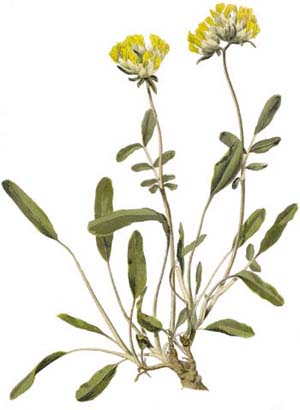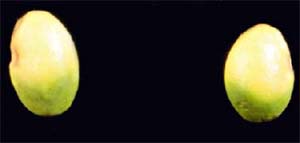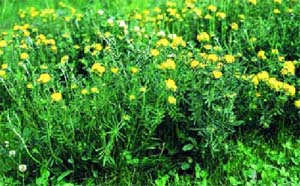Common kidney vetch

Anthyllis vulneraria (Schröter, 1888)
BOTANY
Perennial or annual to biennial, mostly with a robust taproot and a short, single or branched, multiheaded rootstock.
Stem 5-40 cm high, single or branched, mostly ascending or erect, hairs appressed (minimally spiky), whitetomentose to the apex.
Foliage leaves variously pinnate, the basal ones often without leaflets or with one to four reduced pairs of leaflets, the cauline ones (one to six) with seven pairs of leaflets, apical ones sessile, basal ones long-petiolate.
Leaflets oblong-ovate to elliptic or lanceolate, lateral ones 0.25-2.5 cm long and a third to one sixth times as wide, apical leaflet up to 6 cm long and up to 2 cm wide, often almost oblong, rounded to slightly acute on both sides; all leaflets entire, no conspicuous lateral veins. Light blue to chartreuse, adaxially (upper leaf surface) glabrous or scarcely, with appressed hairs, abaxially (lower leaf surface) with densely accumbent, minimally spiky, silky hairs.
Stipules small, largely or entirely sheathing. Flowering heads appear terminal, in fact sessile, in the axils of the topmost foliage leaves that are floral bract-like, broad, 3-7- fid; densely arranged at the apices of the stems and branches, mostly multiflowered. Flowers almost sessile, with short, centrally divided pedicels, 9-19 mm long, erect.
Spherical flower heads with dense, golden to orange-yellow flowers.
Strict cross-fertilizer, flowering between June and August.
SUITABILITY FOR RESTORATION
This central and south European species occurs in the foothills of the Alps, the montane and - as with subspecies alpestris - the subalpine zone. In the valleys it grows mainly on semiarid grasslands; on mountain slopes on calcareous, poor grasslands. It prefers skeletal brown soils, pararendzina, rendzina, stony brown and red loam and initial and bare soils. Found in the Alps up to approximately 1 800 m.

Seeds
This species is suitable for restoration between the foothills and subalpine zones, especially on semiarid and stony sites, combined with low-growing grasses. It protects the soil against surface and depth erosion by means of its leaves, which grow close to the ground, and its extensive root system. Tends not to grow in mass and does not require many nutrients.
SEEDS
Seeds 2-3 mm long, 1-2 mm wide and 0.8-1.2 mm thick; broad-ovoid, sometimes with a slight lateral indentation.
Radicle clinging, not sticking out.
Hilum centrally ventral, round, whitish, with dark border.
Surface colour significant: yellow up to two-third, remaining part green; glossy, smooth.
Pod one-seeded, inflated oblique-ovoid, pilose, dark to black-grey.
Thousand seed weight: 2.3-2.7 g.
REQUIREMENTS
(soil and climate)
Common kidney vetch is extremely undemanding and adaptable, while tolerating fertilization intermediately; even suited to poor habitats with shallow, nutrient-deficient soils. Sites that are too damp and clay and peat soils are not suitable. The pH should not be above 6, otherwise there may be a deficient root development. Kidney vetch prefers arid weather, having a low transpiration coefficient. It has high nitrogen accumulation capabilities, is self-tolerant and a good previous crop for cereals, sweetcorn and rape. As for all legumes, there should be a long crop rotation in order to prevent an accumulation of fungal pathogens.
CULTIVATION
Common kidney vetch needs a fine, crumbly and compact seedbed.
Open sowing is possible throughout the year. In order to guarantee a satisfactory crop yield the following year, seeds should be sown up to July at the latest. According to early literature on seed cultivation of forages, autumn sowing underneath rye is possible in September. Common kidney vetch is suitable as a nurse crop for summer barley or durum. It is not troublesome at sowing.
Seed rate: 8-10 kg/ha.
Row spacing: 12-25 cm, depending on the construction of the seeder.
FERTILIZATION
Phosphorus and potassium: common kidney vetch requires very few nutrients. In autumn before cultivation, basic fertilization with manure (15-20 tonnes/ha) is considered sufficient. Using mineral fertilizer, an application of 60-80 kg/ha P2O5 and 100-140 kg/ha K2O is recommended, depending on soil content.
Nitrogen: kidney vetch meets its nitrogen requirements by means of nitrogen-fixing bacteria. As for all legumes, fertilization with 20-30 kg N is recommended for open sowing in order to stimulate juvenile development.
MAINTENANCE AND WEED CONTROL
In early autumn before the crop year, cutting is recommended if populations are densely grown.
Having low competition with weeds, mechanical weed control should be combined with the application of herbicides. Kidney vetch is not sensitive to the use of curry combs. As for all legumes, specific weed control with herbicides is not always possible. In this context, experiences in clover seed production should be mentioned. However, compared to most clover species, kidney vetch does not tolerate herbicides containing butyric acid (MCPB).

Flowering plants in the second vegetation period
Pests and diseases: common kidney vetch is usally healthy, although several fungus diseases (mildew, focal spot disease, rust and stem fungal) are possible. In the north of Italy, root rot caused by fungal pathogens appears from time to time, which can lead to heavy losses.
Most kidney vetch plants die off after seed ripeness. Plant survival depends on origin, ecotype and sowing time. A second harvest the following year can be profitable if the reproductive populations together with the juvenile plants - grown through seed shedding - remain sufficiently dense. In this case, densely grown populations have to be cut in autumn in order to minimize losses over winter.
HARVEST AND YIELDS
Resistance to lodging: intermediate to low, depending on origin.
Shattering tendency: extremely high.
Ripeness: at time of ripeness florets change colour to silver-grey and pods become dark to black-brown. Seeds become firm (nail test) and change colour to a typical green-yellow. Because of the plant’s unequal ripening and high shattering tendency, harvesting is only recommended when at least 60 percent of the flowers are ripe. Often this state of ripeness is reached when the third axis of flowers at the stem is ripe for threshing.
Ripening period: starting in the middle of July and lasting up to the middle of August, depending on origin.
Harvesting technique: experiments show conspicuously higher crop yields with direct threshing. Swath threshing is not recommended because of high losses through seed shedding. Threshing has to be carried out with great care.
Crop yields: yield forecasts amount to between 200 and 400 kg/ha. Depending on ecotype and weed infestation a second harvest is possible.
Depending on the thresher, harvested seeds can still remain covered with 60 to 90 percent of pods. As is common practice in seed production, seeds should be dried gently immediately after harvesting. Hulling the seeds should be carried out with special machines (clover rubber).